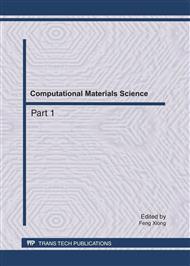[1]
F. Maes, A. Collignon, D. Vandermeulen, et al. Multimodality image registration by maximization of mutual information [J]. IEEE Transactions on Medical Imaging, 1997, 16 (2) : 187-198.
DOI: 10.1109/42.563664
Google Scholar
[2]
JPWPluim, JBAMaintz, MAViergever. Mutual information based registration of medical images: a survey [J]. IEEE Transactions On Medical Imaging, 2003, 22 (8) : 986-1004.
DOI: 10.1109/tmi.2003.815867
Google Scholar
[3]
F. Maes, D. Vandermeulen, P. Suetens, Comparative evaluation of multiresolution optimization strategies for multimodality image registration by maximization of mutual information [J]. Medical Image Analysis. 1999, 3 (4) : 373-386.
DOI: 10.1016/s1361-8415(99)80030-9
Google Scholar
[4]
C. Studholme, DLGHill, DJHawkes, An overlap invariant entropy measure of 3D medical image alignment [J]. Pattern Recognition, 1999, 32 (1) : 71-86.
DOI: 10.1016/s0031-3203(98)00091-0
Google Scholar
[5]
severe. An Improved Adaptive premature convergence of genetic algorithm to determine [J]. Nanjing University of Posts and Telecommunications, 1993, 19 (1) : 35-38.
Google Scholar
[6]
Fanshu Wei, Wang Guoliang, Sheffield. Genetic algorithm to optimize the design of the transformer of [J]. CSEE, 1996, 16 (5) : 346-348.
Google Scholar
[7]
Liu Zhigang, Geng, E, Wang Jianhua and so on. Based on Improved Adaptive Genetic Algorithm Optimization of hollow series reactor design [J]. CSEE, 2003, 23 (9) : 103-106.
Google Scholar
[8]
Harris, C. Geometry from visual motion. In Blake, A. and Yuille,A., (eds. ), Active Vision. MIT Press, (1992) p.263–284.
Google Scholar
[9]
SmithAM, Brady J M.SUSAN. A new approach to low level image processing. 1ntemational Journal of Commputer Vision, Vol. 23-1 (1997) p.45—78.
Google Scholar
[10]
Lown D G. Distinctive image features from scale-invariant keypoints. International Journal of ComputerVision, Vol. 60-2 (2004), pp.91-110.
Google Scholar
[11]
Rafael c. Gonzalez, Richard E. Woods. Digital image processing second Edition, Beijing: Publishing house of electronics industry(2008), pp.519-560.
Google Scholar
[12]
Otsu, N. A threshold selection method from gray-level histograms. IEEE Trans. Systems, Man, and Cybernetics, 9(1) (1979), pp.62-66.
DOI: 10.1109/tsmc.1979.4310076
Google Scholar
[13]
Matthew Brown, David G. Low. Automatic Panoramic Image Stitching using Invariant Features". International Journal of Computer Vision 74(1) (2007), 59–73.
DOI: 10.1007/s11263-006-0002-3
Google Scholar
[14]
LIU Li, SU Min. Chinese: Medical Image Registration Based on Wavelet Transformation and Mutual Information. Journal of Image and Graphics, Forum Vol. 13(2008), p.1317.
Google Scholar
[15]
Sangeetha Somayajula, Evren Asma, Richard M. Leahy, in: PET Image Reconstruction using Anatomical Information through Mutual Information Based Priors. edtied by 4th IEEE International Symposium on, Arlington, ISBI (2007) in press.
DOI: 10.1109/nssmic.2005.1596899
Google Scholar


